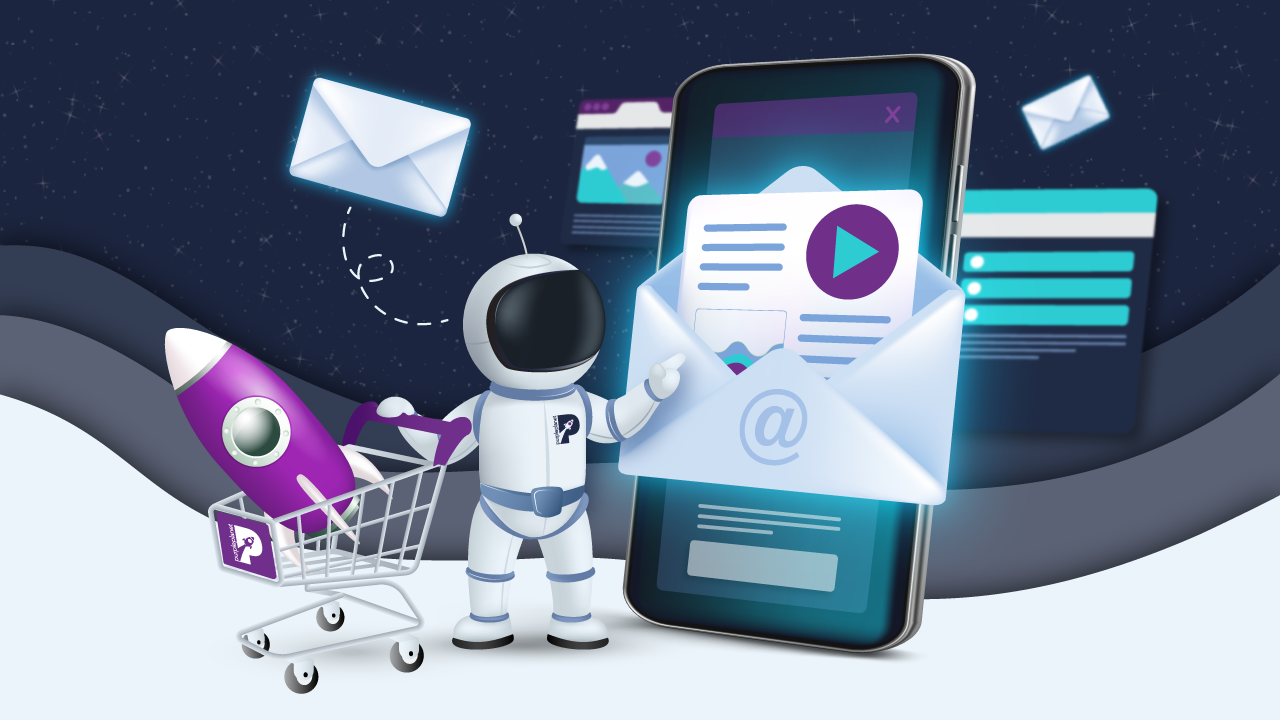

E-Commerce Email Marketing – Top Tips to Increase Sales
Why Should E-Commerce Businesses Invest in Email Marketing?
When your whole business is online, email marketing is how you can acquire new leads, keep existing leads interested, and continue growing your company.
Email marketing can achieve things that regular shops can’t. While e-commerce brands can chase up abandoned carts, retail assistants can’t chase window shoppers down the street.
Since email marketing isn’t restricted by location, it allows companies to grow globally and reach customers within their own homes.
Though e-commerce brands can use their website, SEO, and social media to engage leads, they can’t use these channels to land right in users’ inboxes. Thus, email is a crucial pillar of marketing that can’t be ignored.
Not convinced? For each dollar spent on email marketing, businesses can expect an average return of $40.
Keep reading to learn everything business owners need to know about e-commerce email marketing:
How Does Email Marketing Work? An Overview:
Here’s a beginner’s guide to how email marketing works:
- First, you create a sign-up form that gets people to leave their contact details via your website. This is set up to add their email addresses to your mailing list.
- You then create effective emails through good design, effective copywriting, marketing tactics, and brand personality.
- You send promotional emails to increase sales, incentivise purchases, stay connected with customers, and share important company information when policies change.
- You regularly clear out unengaged subscribers from your mailing list and take other actions to protect your sender’s reputation.
- You review email marketing performance data with the help of dedicated tools to examine and improve your processes.
- You might need to hire specialists to help with certain aspects of your email marketing, such as a designer, copywriter, or marketing manager.
Pros and Cons of Using Email Marketing in E-Commerce
You might be wondering whether email marketing’s right for your brand. Though it has some disadvantages, you might be swayed when you understand its benefits:
Pros:
- Email marketing is typically affordable but especially when compared to other marketing channels.
- Email marketing is permission-based, which means subscribers are genuinely interested in receiving messages from your brand.
- Email marketing is scalable, so it can suit your business, whatever stage it’s in.
- Through audience segmentation, deep levels of personalisation can be achieved, which isn’t possible with even paid advertising channels.
- Email marketing efforts are highly and easily trackable through the use of a few metrics.
- Every company using email marketing has the potential to reach a massive, global audience.
- Businesses can use email marketing to reach leads in real-time as emails can be triggered by events, e.g., abandoned carts.
- Email marketing is non-intrusive. While people might scroll past ads or hang up on cold calls, individuals can return to your emails at a time that suits them, which not only gives your messages longevity but also nurtures the buyer’s journey in that the lead feels in control of their decisions.
- There are loads of affordable email marketing tools that can help with all stages of your campaigns if you don’t have an expert on your team.
Cons:
- Email marketing leads aren’t always qualified, so they may need to be weeded out down the line.
- You could get marked as spam through no fault of your own (a subscriber could be overwhelmed by the number of promotional emails they’re receiving from multiple businesses).
- Email design is sometimes viewed as restrictive compared to the creative potential posed by other advertising options.
- You’ll have to maintain your sender’s reputation and be aware of the spam prevention techniques used by email providers.
- You’ll need skills, money, and resources. Sometimes small businesses might have to overly simplify their email marketing campaigns if they don’t yet have a big enough budget to hire several contractors.
How to Build a Successful Mailing List
Make it easy and attractive for people to sign up
First, you need to create a subscription form that will appear on your website – either as a pop-up, in the footer, or on landing pages.
Sign-up discounts are likely to encourage more people to leave their details, as well as forms that aren’t too complicated to fill in. For more information on creating lead capture forms, check out this article.
Keep subscribers engaged
Email marketing can be used at every point of the buyer’s journey: from reaching leads at the Awareness, Consideration, and Action stages to post-purchase Support and Bonding stages.
Check out the section below, where we discuss different types of email you can use to engage subscribers at different points in their buyer’s journeys.
Whilst there are things you can do to keep subscribers engaged, there are also things to avoid doing to prevent subscribers from becoming disengaged. View the section below to learn what these are.
Segmenting your mailing list
Segmenting your mailing list means creating smaller, targeted lists so that subscribers receive emails that are more personalised and relevant to them. Meanwhile, this also benefits e-commerce companies as they’re more likely to achieve certain email marketing goals when using audience segmentation:
Not only do individuals feel emails are relevant to them, but they also don’t have to suffer the annoyance of irrelevant emails. This means your sender’s reputation is better protected, and users are less likely to become tired of your messaging.
When to let subscribers go
You might think “bigger is better”, but that’s not always true with mailing lists. Companies need to be clearing out unengaged email addresses every 3-6 months. Keeping hold of unengaged subscribers will just harm your metrics and risk your sender’s reputation.
Rooting out tired and disengaged leads will boost your CTR and give you a more accurate idea of your email performance.
What NOT to do
Be cautious of sending unsolicited emails. If you’ve gathered email addresses in a way that isn’t GDPR compliant, you’re breaking the law. Moreover, your emails will likely be marked as spam or not opened – which will harm your sender’s reputation.
Don’t make the mistake of sending loads of emails really frequently – that’s called spam. You might think it’s beneficial to be constantly in your subscribers’ inboxes, but that couldn’t be further from the truth. Companies sending fewer, higher-quality emails will see better results.
Types of Emails to Send
Welcome emails
A welcome email is what carves a first impression. Express your happiness and gratitude that this individual has shown an interest in your company! Use their first name and perhaps use the email as a space to explain more about the business’s values and what it offers.
Typically, welcome emails offer a first-purchase discount of 10% or more. These offers are so common that users almost expect them when they sign up. (You might even advertise the discount on your sign-up forms to entice visitors!) A discount is a great way to get those leads under your belt and help them try out your products or services.
The average open rate for companies across all industries is 19.7%, whilst it’s 68.6% for welcome emails! This means there’s a larger potential for sales with this initial email.
Anniversary emails
Anniversary emails aren’t very common, so they can positively surprise subscribers and convey a pleasant company ethos.
They can be used to mark a year signed up to your mailing list, a special birthday message, or mark a re-purchase if your company sells repeat-purchase products.
Anniversary emails are more personal than other types as they take personal information into account specific to individual users. In this way, customers can feel more considered and cared for by your brand.
Repeat-purchase reminders need to be calculated carefully, so work out how long your products typically last and send those emails when your customers are near to finishing them.
Abandoned cart emails
Abandoned cart emails allow you to catch those almost-customers. The Consideration phase is a crucial part of your sales funnel, and even a small discount could be what that lead needs to convert to the Action stage.
Did you know that sending 3 abandoned cart emails results in 69% more orders than just 1 email?
Special deals emails
Promoting special deals is a great way to re-engage email subscribers, clear out excess stock, and generate interest in unknown or new products.
Discounts and special offers that focus on just one CTA see better results than those with multiple CTAs. They’re also much easier to build and straightforward to measure.
Referral emails
We already know the value of subscribers sharing or referring your brand to their friends and family – it’s a great way to generate new leads. You can increase referrals by offering your subscribers an incentive when they successfully refer a friend. You might offer a free gift or a one-time discount.
Before building your ‘refer-a-friend’ scheme, calculate your cost-per-customer-acquisition first. This will tell you how much you can afford to offer as an incentive whilst remaining in profit.
Newsletter emails
Newsletters can bring a lot of value to e-commerce brands. They’re typically used for educating subscribers and establishing brands as industry thought leaders. For instance, you might release newsletters that explain industry news or provide more information about your products or services.
For example, a skincare brand might use its newsletters to discuss winter skincare, an upcoming range of products, or a new scientific study about SPF. Whatever it is your company sells, a newsletter is a longer-form way of staying in touch with your users and creating a conversation.
If you have a regular blog, this is something you could promote in your newsletter to drive more users towards your site and onto product pages from there.
Feedback emails
Since feedback is an essential component of Customer Relationship Management (CRM), your access to customer email addresses is a goldmine – so it should be used!
Sometimes an incentive is needed to encourage users to complete satisfaction surveys, but other times their strong feelings will be enough. Sending feedback requests after a sale (and delivery) is a great time to get in touch, as customers will have fresh feelings about their experience.
How to Optimise Your Emails
We’ve all received promotional emails that seemed spammy or had broken links and too many CTAs.
Building and designing effective emails is an art, and you may need to invite a designer to join your team to help with it. Though this will come at an expense, it’s as important as having a well-designed website or a firm handshake.
Well-designed emails with good visual hierarchy, proper colour theory, and optimised use of copywriting see better results. With that in mind, make sure you keep the following in mind when designing your emails:
- Optimise your emails for both mobiles and desktops
- Choose enticing headers and subject lines
- Optimised use and design of CTA buttons
- Easy-to-read font
- High-quality images
- Attractive use of colour that’s easy on the eyes
- Play around with small and big elements to draw attention to specific sections
- Consider visual hierarchies
- Ensure links are functioning properly
- Build in sections needed for personalisation
- Be aware of the name in the email address you’re sending from
Which Email Marketing Metrics Should You Track for E-Commerce?
1. Clickthrough rate
Your CTR is the percentage of subscribers who clicked on one or more of your email’s embedded links. You can calculate it by:
(total clicks / number of emails delivered) x 100
CTR easily indicates each email’s performance and user engagement levels. You might find that it’s the main metric measured in A/B tests because the intention of these tests is often to determine how emails can be more ‘clickable’.
2. Bounce rate
When talking about emails, the bounce rate refers to emails that couldn’t be delivered. You can calculate this by:
(total bounced emails / total sent emails) x 100
Bounce rate is very important when it comes to your sender’s reputation as it’s used by internet service providers to determine your trustworthiness.
Be aware of both soft and hard bounces. Hard bounces occur when the email inbox is closed or invalid – you should remove these email addresses immediately. Soft bounces occur due to temporary issues that are sometimes resolved by resending the email or waiting till the problem on the recipient’s end clears up.
Bounce rate is only an issue if there’s a risk to your sender’s reputation. (It’s normal to have a few bounces.)
3. Conversion rate
Your email conversion rate relates to the percentage of subscribers who completed a specific action, such as clicking on a link and making a purchase. You can calculate it by:
(number of subscribers who completed action / total delivered emails) x 100
Conversion rate is crucial when examining the success of your CTAs, and, more widely, your overall business goals.
4. List growth rate
This KPI tells you the rate at which your mailing list is growing. You can calculate it by:
(((number of new subscribers) – (number of unsubscribes + spam flags)) / total number of subscribers) x 100
The growth of your mailing list may tell you about the efficacy of your mailing list sign-up forms or landing pages, but it’s natural for mailing lists to decline each year. Therefore, a plateauing growth rate doesn’t necessarily mean you’re not obtaining new subscribers.
Keep an eye on this one, as it’s essential your mailing list is a good size.
5. Unsubscribe rate
This metric indicates the percentage of subscribers who unsubscribe after opening a given email. You can calculate it by:
(total unsubscribes / total emails delivered) x 100
You may also want to include those individuals who have flagged you as spam in this calculation.
The unsubscribe rate isn’t to be fully relied upon as some subscribers will show their disinterest by not opening your emails or opening but not reading them – which you can’t know for sure. It’s much better to look at actions taken to measure engagement through metrics such as conversion rate, sharing rate, and clickthrough rate.
6. Open rate
Your open rate is simply the percentage of subscribers who open an email. You can calculate it by:
(number of opened emails / number of delivered emails) x 100
Though the open rate is useful when comparing emails over time, it doesn’t tell you a lot at face value. Emails can be opened but not read; they can be opened and forgotten about. In this way, open rates are often vague and don’t tell a clear picture. So, they’re not to be overly relied on.
7. Sharing or forwarding rates
Your sharing or forwarding rate tells you the percentage of users who are sharing your emails on social media or with friends. You can calculate it by:
(number of clicks on ‘share’ or ‘forwarding’ button / total number of emails delivered) x 100
This metric tells you a lot about customer satisfaction and engagement levels. It’s often overlooked but can be crucial in attracting new leads and subscribers – so don’t ignore this metric.
8. ROI
Your ROI is the return on investment you’re getting on from your email campaigns overall – though you could calculate it for individual emails if you wanted to. You can calculate the overall figure by:
((£ in campaign generated sales – £ spent on campaign) / £ spent on campaign) x 100
Return on investment is highly important as it shows the real, tangible results of your labour. You might use it to compare different email campaigns to evaluate the success of different techniques or just use it when managing budgets. Either way, it’s the bottom line to indicate success in most cases.
5 Best E-commerce Email Marketing Tools
Some tools can be extremely helpful in automating your email marketing strategy…
MailChimp (for beginners)
If you’ve considered email marketing, you’ve likely heard of MailChimp. It was the most popular email marketing tool in 2021 and 2022, boasting increases of 88% in revenue to their customers.
MailChimp is a purely marketing software, so it can’t do as much as other tools; however, it is very simple to use, making it ideal for beginners.
On a free MailChimp plan, you’ll have a limit of 2500 sends each month, and a maximum of 500 contacts. You’ll have access to many email templates, though the level of customisation isn’t as high as it is with a software like HubSpot.
HubSpot (all-in-one)
HubSpot has the advantage of being an all-in-one tool, but that isn’t necessarily relevant if you just need help with your email marketing.
On HubSpot’s free plan, you’re limited to 2000 sends per month, even though you could have an unlimited number of contacts. If you do want to upgrade to more extensive plans, it can be costly, and the software itself isn’t entirely straightforward to use.
Though HubSpot has a steep learning curve, this means you’ll have access to highly advanced automations and plenty of customisation for email designs.
Drip (e-commerce)
Drip focuses on email marketing and automation, much like the other tools in this list, but specifically targets e-commerce businesses.
The general consensus is that Drip is just as good as MailChimp but doesn’t have the same reputation due to its age (being founded 12 years after). This is unfortunate, as Drip’s automation builder is much more advanced and visually pleasing.
Drip’s starting costs are almost double MailChimp’s; however, Drip has a much sleeker user interface and more unique features when building email campaigns.
Klaviyo (e-commerce)
Though Klaviyo doesn’t prioritise usability, it does make up for it with lots of features and in-depth customisation, audience segmentation and automation options.
Though Klaviyo is one of the more complicated interfaces, it does offer lots of guidance when you sign up.
Mainly focusing on email and SMS marketing, Klaviyo doesn’t offer help with landing pages or social media, and its free plan only allows for half as many subscribers as MailChimp’s.
If your main concern is e-commerce, Klaviyo has lots of room for your requirements, e.g., automated alerts, integrations, and broad goal achievements that all suit larger companies.
Salesforce (for CRM and reporting)
Salesforce boasts extensive marketing features and high levels of customisation, coming neck-and-neck with its competitor, HubSpot.
The standout aspect of Salesforce is its CRM and reporting. Salesforce’s dashboard makes it really easy to see your entire e-commerce profile at a glance – which is great for busy business owners and companies with lots of projects on the go.
Though it offers a free trial, you can’t get a free plan with Salesforce. However, its pricing plan includes add-ons, which means you don’t need to pay for any features you don’t need.
Ultimately, Salesforce is very similar to HubSpot – which is a much cheaper and more well-rounded tool.
Final thoughts
If your business is digital, it makes sense that your customer acquisition and lead nurturing channels will be digital too. You could choose to make use of social media and search engine ads, but these channels won’t allow you to follow up with potential leads or nurture them post-purchase.
Optimising your email marketing is crucial, though, since so many email users are tired of spammy, irrelevant, or pushy commercial emails. Figure out how yours can stand out, and you’ll be reaping
If you feel that you need help with email optimisation, do get in touch with our team.











